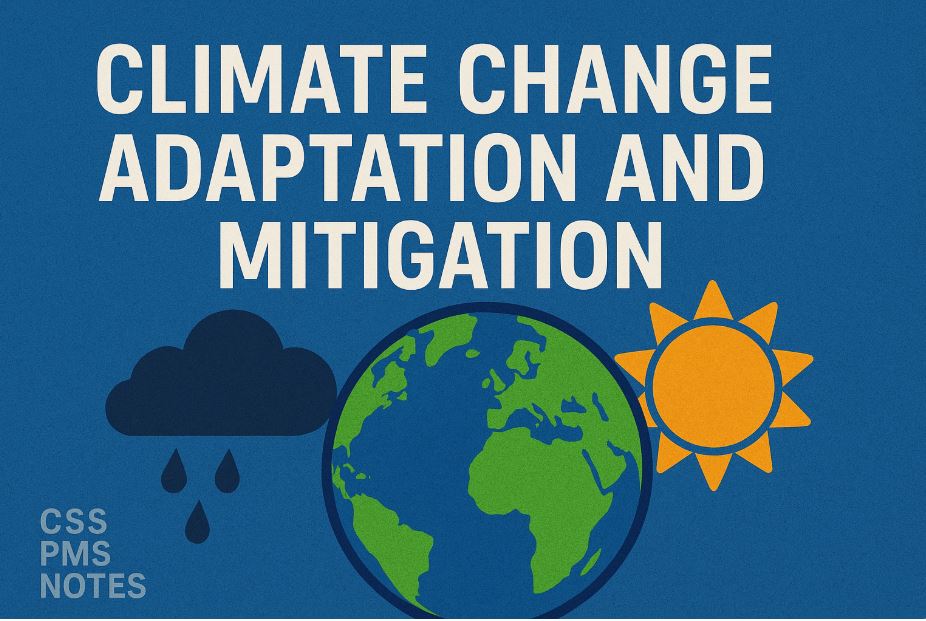Climate Change Adaptation and Mitigation: Two Paths to Save Our Planet

Introduction — Why This Matters
Climate change is one of the biggest challenges facing our world.
Rising temperatures, melting ice, droughts, and floods are changing how we live.
But there are two main ways to fight it: Adaptation and Mitigation. These two approaches work together to protect our planet and people.
Let’s explore what they mean, how they work, and why both are crucial.
What Is Climate Change Adaptation?
Adaptation means adjusting to the impacts of climate change.
It’s about preparing for what’s already happening — and what’s coming.
Examples of Adaptation:
- Building flood walls to protect coastal cities.
- Planting drought-resistant crops for dry areas.
- Improving water storage and irrigation.
- Creating early warning systems for storms.
- Shifting homes and farms away from flood zones.
Goal of Adaptation
To reduce vulnerability and build resilience so communities can survive and recover faster from climate shocks.
According to UNDP, adaptation is “a crucial part of climate action because impacts are already happening and increasing each year.”
(Source: UNDP Climate Promise)
What Is Climate Change Mitigation?
Mitigation means reducing or preventing greenhouse gas (GHG) emissions.
It tackles the root cause of climate change — too much carbon dioxide and methane in the atmosphere.
Examples of Mitigation:
- Switching to renewable energy like solar and wind.
- Reforestation — planting trees to absorb carbon.
- Improving energy efficiency in buildings and transport.
- Reducing industrial emissions.
- Promoting electric vehicles.
NASA explains mitigation as actions that reduce the sources of climate change or enhance the sinks that absorb carbon.
(Source: NASA Climate Science)
Adaptation vs. Mitigation: What’s the Difference?
| Feature | Adaptation | Mitigation |
|---|---|---|
| Goal | Manage the effects of climate change | Reduce greenhouse gases |
| Timeframe | Short to medium term | Long term |
| Example | Building sea walls | Installing solar panels |
| Focus | Local and regional | Global |
| Outcome | Reduces vulnerability | Slows climate change |
Both are vital. Without mitigation, future climate impacts will worsen. Without adaptation, communities will suffer from the impacts already here.
(Source: European Environment Agency (EEA))
Why We Need Both
The world must mitigate to limit temperature rise — but we also must adapt to survive its effects.
- Adaptation protects people now.
- Mitigation protects future generations.
- Together, they form a complete climate strategy.
📘 As NASA and the UN both state, combining adaptation and mitigation gives the strongest response to climate change.
How Countries Are Acting
Adaptation Actions:
- Bangladesh builds raised homes and floating gardens.
- The Netherlands invests in smart dikes and flood barriers.
- African nations use drought-resistant seeds.
Mitigation Actions:
- The EU aims for net-zero emissions by 2050.
- China and India expand solar energy.
- The U.S. promotes electric vehicles and clean energy.
Global Climate Facts (UNDP & NASA Data)
| Indicator | Current Status | Source |
|---|---|---|
| Global average temperature rise | +1.1°C since pre-industrial era | NASA |
| Annual CO₂ emissions | 36.8 billion tonnes (2023 est.) | UNDP |
| Sea-level rise | 3.4 mm per year | NASA |
| Countries with climate adaptation plans | Over 120 | UNDP |
How You Can Help
Small actions matter too.
You can contribute to climate change mitigation and adaptation by:
- Saving energy and using efficient appliances.
- Reducing waste and recycling.
- Supporting tree planting projects.
- Using public transport or biking.
- Raising awareness in your community.
Conclusion
Climate Change Adaptation and Mitigation are not separate paths — they are two sides of the same coin.
We need to adapt to survive today and mitigate to save tomorrow.
Together, they create a cleaner, safer, and more sustainable future for our planet.
FAQs about Climate Change Adaptation and Mitigation
1. What is the main difference between adaptation and mitigation?
Adaptation manages the effects of climate change. Mitigation reduces the causes of it.
2. Why is adaptation important?
Because climate impacts like floods and heatwaves are already happening. It helps people cope and recover.
3. How does mitigation help the environment?
Mitigation cuts greenhouse gases, slows global warming, and prevents extreme weather in the future.
4. Can adaptation and mitigation work together?
Yes, they are complementary. For example, planting trees helps reduce emissions and prevent soil erosion — both adaptation and mitigation.
5. Which countries lead in mitigation efforts?
The European Union, the U.S., and China lead in renewable energy, emission reductions, and climate policies.